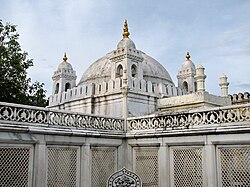This article is written like a travel guide .(June 2023) |


Aurangabad is a historic city in the Maharashtra state of India. The city is a tourist hub, surrounded by many historical monuments, including the Ajanta Caves and Ellora Caves, which are UNESCO World Heritage Sites, as well as Bibi Ka Maqbara and Panchakki. The administrative headquarters of the Aurangabad Division or Marathwada region, Aurangabad, is said to be a City of Gates and the strong presence of these can be felt as one drive through the city. In 2010, the Maharashtra Tourism Minister declared Aurangabad to be the tourism capital of Maharashtra. [1] [2] It is also one of the fastest-growing cities in the world. [3]
Contents
- History of Aurangabad
- Tourist attractions in the city
- Tourist attractions in Aurangabad District
- Excursions outside Aurangabad District
- See also
- References












